Very useful in the household box: WD TV Live - HD media player
If you, like me at one time, got tired of connecting the laptop / computer to the TV every time in order to enjoy the movie on the big screen, if you, like me, want to have a simple, like a slipper, device without unnecessary frills, however, it does what you want from it, with the help of a few simple buttons on the remote control - then you, like me, have matured to acquire a specially designated box for this, called a media player. A review of one of them, which I have been using for a couple of weeks, I submit to your attention.

The idea of organizing a multimedia center was born a long time ago, and the first option was to assemble myself on the basis of the Mini-ITX, but the prospect of assembling a bundle on the bottom of the barrel, picking it all up with my hands, installing and configuring software, screwing the remote - absolutely not pleased. I was lazy, I wanted to get ready and compact device that performs what is required of him. Like, for example, Popcorn, known to many. But at the sight of Popcorn (and the prices for it) something in my head did not grow together: well, such a thing should not cost so much. Well, in any case, there should be cheaper analogues! And I began to dig the Internet, as a result of which I dug a very interesting Mvix Ultio device with a price of $ 170 and already practically bought it - but I came across a video review in time , which made me hold my horses. The interface is clumsy, and the brake is also a bargain - not-e, this isnot Rio de Janeiro , which is not what I'm looking for. And already almost disappointed I found IT! Togo, which now stands under the TV and fun winks LED. I must say that a brief overview of the earlier model was already on Habré , but this model differs from the previous one in the presence of a network interface, which is a very significant difference.
So, the media player WD TV Live . It is a small box with dimensions of 12.5 cm x 10 cm x 4 cm, made of dark gray plastic in the shape of a parallelepiped with a slightly rounded front panel.

On this panel there is a small scoreboard with indicators for powering on and connecting USB disks, as well as the “eye” of the IR receiver.
On the right side there are only slots for cooling, they are on the left side, there is also one USB port. The second USB port is located at the back. There is also a HDMI output, optical audio output, Ethernet port, component and composite video outputs.
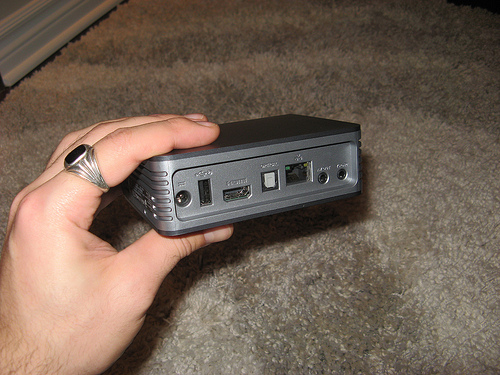
There is nothing extra-ordinary, but everything that is most needed is present. No moving parts, passive cooling, the device is completely silent.
')
Take a quick look at the contents of the box: the device itself, the power cord, the cords for the composite / component outputs, the manual, a CD, a remote control, batteries for it. The console is small, there are hardly a couple dozen buttons, there is absolutely no reason to guess about the purpose of each of them.
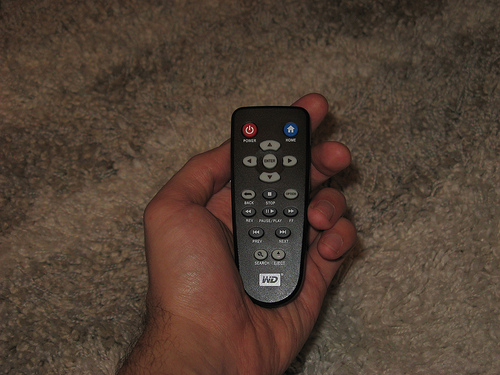
Yes, why examine - let's better turn on! We connect to the TV, turn on. It is loaded (~ 35 seconds - but this is only from a “cold start”, when the power is physically disconnected, and if you turn it off with a button from the remote control, it turns on in 5 seconds) - and this is what we have been waiting for, it happened. I immediately plugged the Ethernet into it, and while I was mastering the remote and wandering around the menu, the device found a firmware update on the network and offered to install it. I must say that I am sometimes suspicious of updates, so I first of all climbed into the network to check whether there are any known problems that have arisen in the new version (and at the same time find out more about the firmware process). The process itself is utterly simple: either the device does it itself, over the network, from the manufacturer’s website, or you can do it manually. Manually done this way: the archive is downloaded, unpacked on a flash drive, if necessary, the version in the text file (one of the files on the flash drive) is corrected and the flash drive is stuck into the device. After that, he himself detects the presence of firmware (if its version is higher than the current one) and offers to upgrade. Agree, wait a bit - and you're done.
In the process of searching for information on the firmware, I discovered an interesting third-party firmware from a certain B-RAD comrade , which extends the functionality of the device practically “to the skies”. I decided to check it out on my own skin (making sure that if anything happens, I can roll back). So, the features added by the firmware from B-RAD (incrementally, in order of increasing importance for me personally):
First, it is possible to connect an external DVD-drive and watch movies from disks (if you suddenly have someone lying around). For me personally, this is not particularly relevant.
Secondly, support for a number of Wifi-USB adapters is added. Until recently, this was valuable to me, but now, with the presence of gigabit around the house, not really, but I know, it will please many.
Next: customization of the appearance (changing the number of displayed items when viewing the contents of directories, changing the wallpaper, changing the screensaver screensaver)
FTP server (pure-ftpd). Well, it’s not really necessary, but let it be. There are no requests (besides, you can turn it off if you really don't need it at all).
SSH server. See above :)
And finally: a torrent client. Full console Deluge with web-guyom, accessible from any neighboring company (or even outside, with proper configuration of the router). Now this is more interesting: we take DynDNS, we forward the port on the router - and add downloads from anywhere, even from work, even from the beach.
Well, since there is a web-gui for Deluge - is it spinning on something? Right, the web server is lighttpd. Although for what it is needed except for the Deluge web-muzzle - I don’t know, hardly anyone will host the site on the media center :)
The ability to mount NFS-balls. All the hands did not reach to organize this business in my network. I hope in the near future I will definitely take advantage of this opportunity.
I will not forget to mention that for special aesthetes there is an opportunity to install an ordinary Debian, but the purchase of this device by me was just aimed at not installing anything, so I would hardly use this opportunity :)
In general, immediately there are several possible scenarios for using the device. You can connect a USB drive to it and download directly to it, distributing downloaded to the network. You can remove the “rocking” functions from it by downloading the home server, and only play with the subject by picking it up via SMB. You can download the device to the mounted NFS-disks, physically located on the server. Why in this case, download the device, and not by the server itself? Then, that the device has already installed and configured a torrent client with web gaming :)
In general, there are many scenarios for every taste. But pretty lyrics. I flooded this firmware, let's move on to the pictures. I apologize in advance for the photos from the screen, but I haven’t found a regular way of taking screenshots in the device, but I don’t have a video capture card with HDMI. Fota slightly at an angle so as not to blink.
So, the main menu looks like this: a vertically positioned ribbon, the transition between the elements of which is carried out by the buttons of the console. Select the item - go to the next tape. The transition is smooth, without delay. In the main menu there are 4 items: Video, Audio, Photo, Settings (I will operate with English terms, because I use this interface language, but in the settings there is an opportunity to select a language, including Russian). Scroll through the menu items.

Of course, we will immediately get into “Video” - why did we buy it? The section contains the items “Local drives” (present only if a USB drive is connected), “Media servers”, “Network shares”, “Youtube”.

At the entrance to the “Local drives” and the choice of the device, several options are offered to choose from: sort by date, by catalogs, watch the latest videos or browse through playlists (if available). Actually, from this moment you can start using the device for its intended purpose: to watch movies. Actually, what I bought it for: so that without getting up from the couch, push the button - and that's all. But you don’t push a lot on the flash drive, and I haven’t yet purchased an external and capacious USB drive, so we’ll go back to the next level and go to the next menu item “Video” - “Network shares”. I go there and instantly discover my desktop there, when I select it, I see a list of shared directories.

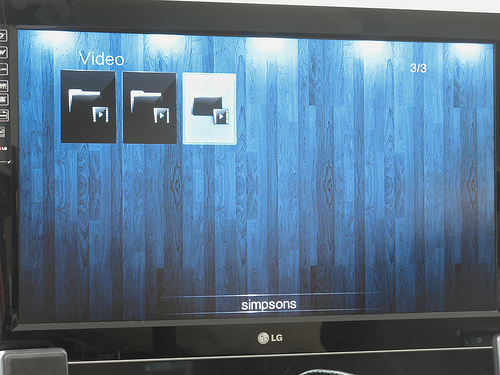
I was pleased that the Cyrillic alphabet was displayed correctly (on the desktop - Ubuntu with the UTF-8 locale). Actually, there is nothing special to tell here: poking through directories, choosing a movie - we are watching. Everything is exactly as I wanted: just like sneakers.
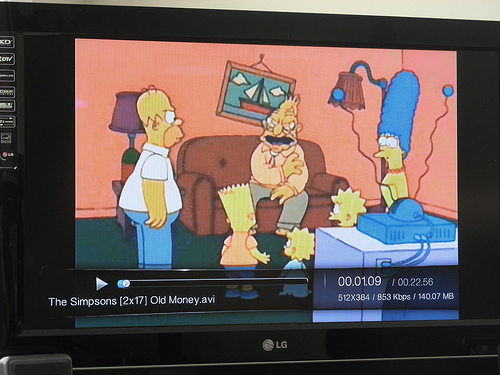
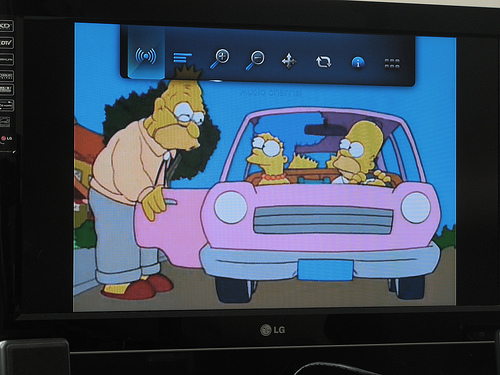
While watching a movie, you can change the audio track (if the movie contains several tracks), the language of the subtitles, you can enlarge the picture and move it slightly to the side. Runs forward / backward at speeds of 2x, 4x, 8x, 16x. Unfortunately, you cannot “skip” over the file (for example, jump forward for a minute or go straight to a certain time mark), or at least I did not find how to do it ( UPD: in the comments suggested that you can go forward / backward) in jumps of 10 minutes). He eats everything that I tried to feed him. On the manufacturer's website declared support for AVI (Xvid); AVC; MPEG1 / 2/4); MPG / MPEG; VOB; MKV (h.264; x.264; AVC; MPEG1 / 2/4; VC-1); TS / TP / M2T (MPEG1 / 2/4; AVC; VC-1); MP4 / MOV (MPEG4; h.264); M2TS; WMV9.
Well, take a look at Youtube

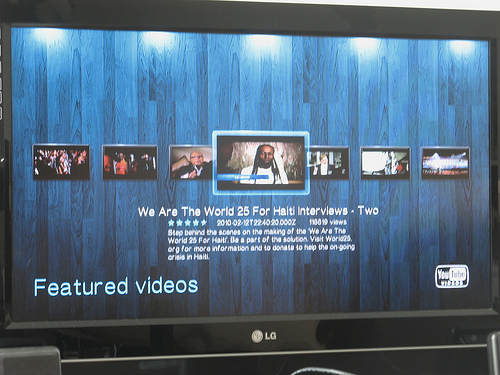
Well, with the video sorted out, we go further.

The same items are Local drives, Media servers, Network shares, and Live365.com and Pandora are additional services. Pandora immediately suggested that I log in, so I set it aside and turned my gaze to Live365, which you can use without registering (but you can log in), there is a set of free radio stations that you can add to your favorites.
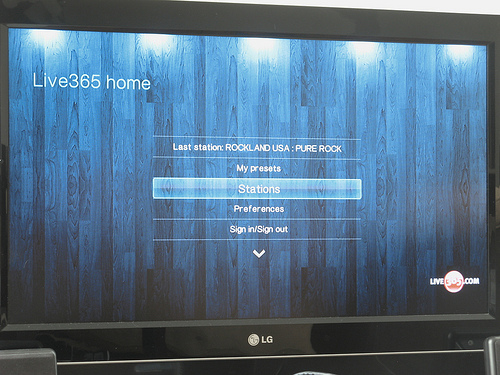
The list of radio stations itself looks like this:

Having chosen the interesting one, we get into the player window, which starts playing, telling which song of which artist is currently playing and displays the cover:

Okay, we figured out the radio, let us return, again, to more vital matters, namely to music shared from the desktop. It's all the same way as it was with the video: open the list of shared directories, navigate through them, choose what we want to listen. Here a well-sorted and orderly collection will serve you well. Here, for example, what will be displayed if everything is arranged in catalogs, sorted by year / album, and with carefully found album covers (like mine :))

The player looks like what we saw when playing a radio station. Displays the name of the track, album, artist, genre, next track. But for some reason, the cover is not displayed here - a very strange fact.
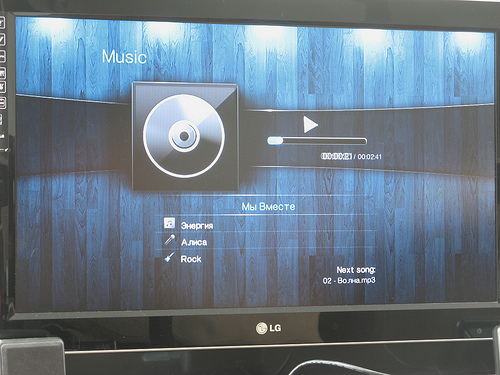
He plays everything that I fed him: mp3, ogg, flac. The manufacturer claims MP3 support; WAV / PCM / LPCM; WMA; AAC; FLAC; MKA; AIF / AIFF; OGG; Dolby Digital; DTS.
Everything is very familiar: Local drives, Media servers, Network shares, and as an additional service - Flickr. But in a strange way, it is offered for use: it is impossible to log into your account and watch your photos. You can only wander aimlessly on the "Last interesting for 7 days", "Recent downloads" and so on. Why is there "My Contacts" and "My Tags" if you can not specify your account (neither here nor in the general settings (to which we still reach) I did not find such an option)? Riddle. Well, okay, who's what about - and I'm on shared resources on the desktop :)

Everything is as good, simple and convenient with them as with music and video: we walk, we look, everything is easy and understandable. If there are photos in the catalog, then the first photo from the catalog (with the catalog icon in the corner) becomes the icon of the catalog itself, which looks pretty nice.


Well, normal viewing. You can switch manually, you can view in a slide show (the interval is adjustable). What is not very much - manual switching slows down. Whether due to the network, or by itself - I do not know, but it works with a delay of a couple of seconds. At the same time in the slide show mode switches exactly with the interval with which it is set. Standard options: rotate left / right, zoom, pan, slideshow options, show / hide information panel button.
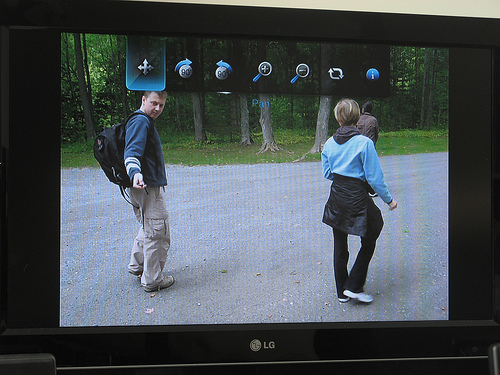
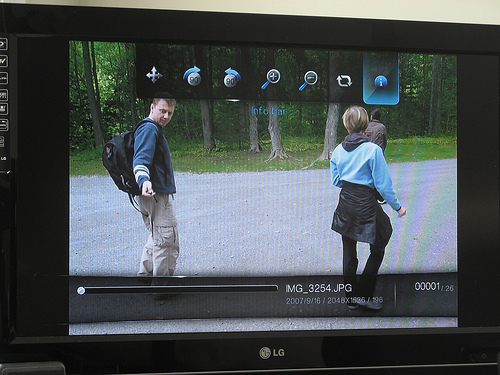
I think I will not be tired of listing all the settings - and so the article turned out to be quite long. There are a lot of settings, but they are practically not required. The only thing I did right away was to remove the fading effect when switching between screens — it was annoyingly terrible, eating 2 seconds at each transition. The rest is an amateur.
You can configure the network connection either by DHCP or manually. You can customize the display of file lists: a list or thumbnails. There is also a file manager that allows you to copy, for example, from a network of balloons to a USB drive or delete something.
If you have read this far, then the device is of interest to you, which means you are terribly interested in finding out the price for this happiness (although the most impatient, you may already google :)). The price killed me so much that I could not believe my happiness: $ 149.99 on the manufacturer's website . In the above-mentioned topic is called a very similar price, and in rubles, so most likely it is for this price that the device can be purchased on the territory of Russia and neighboring states.
So, what we have in the dry residue:
Pros:
* little
* silent
* moderate energylope
* omnivorous
* at the minimum labor costs acquires additional functionality (torrent, ftp, ssh, wifi, DVD).
* price !!!
Minuses and shortcomings:
* no built-in disk
* no eSata connector.
* video player: the inability to go to a specific place of the film ( UPD: in the comments suggested that you can jump on the file in 10-minute increments)
* music player: the cover is not displayed during playback
* photo: brake manual switching.
Whether the listed disadvantages outweigh all the advantages that the device possesses - here everyone will have to decide for himself.
Overall impression: the device is suitable for both a simple inexperienced user who needs “just to work” and a geek who loves to pick it up uninterruptedly (right up to installing a regular Linux there). With a very attractive price, the device may well compete with more expensive counterparts, while leaving behind an opportunity with the help of third-party firmware to expand its functionality so that the "older comrades" can seriously think about their price;)
UPD: in case someone is interested in information about the processor:
# cat / proc / cpuinfo
system type: Sigma Designs TangoX
processor: 0
cpu model: MIPS 24K V7.12 FPU V0.0
Initial BogoMIPS: 332.59
wait instruction: yes
microsecond timers: yes
tlb_entries: 32
extra interrupt vector: yes
hardware watchpoint: yes
ASEs implemented: mips16
shadow register sets: 1
VCED exceptions: not available
VCEI exceptions: not available
System bus frequency: 333000000 Hz
CPU frequency: 499500000 Hz
DSP frequency: 333000000 Hz
This is what top says when playing an MKV file with a size of 6.6GB (resolution 1920x816, 9680 Kbps):
Mem: 192848K used, 6016K free, 0K shrd, 1376K buff, 113744K cached
CPU: 8.7% usr 9.3% sys 0.0% nic 58.0% idle 14.1% io 0.0% irq 9.7% sirq

Preamble
The idea of organizing a multimedia center was born a long time ago, and the first option was to assemble myself on the basis of the Mini-ITX, but the prospect of assembling a bundle on the bottom of the barrel, picking it all up with my hands, installing and configuring software, screwing the remote - absolutely not pleased. I was lazy, I wanted to get ready and compact device that performs what is required of him. Like, for example, Popcorn, known to many. But at the sight of Popcorn (and the prices for it) something in my head did not grow together: well, such a thing should not cost so much. Well, in any case, there should be cheaper analogues! And I began to dig the Internet, as a result of which I dug a very interesting Mvix Ultio device with a price of $ 170 and already practically bought it - but I came across a video review in time , which made me hold my horses. The interface is clumsy, and the brake is also a bargain - not-e, this is
And here he is!
So, the media player WD TV Live . It is a small box with dimensions of 12.5 cm x 10 cm x 4 cm, made of dark gray plastic in the shape of a parallelepiped with a slightly rounded front panel.

On this panel there is a small scoreboard with indicators for powering on and connecting USB disks, as well as the “eye” of the IR receiver.
On the right side there are only slots for cooling, they are on the left side, there is also one USB port. The second USB port is located at the back. There is also a HDMI output, optical audio output, Ethernet port, component and composite video outputs.

There is nothing extra-ordinary, but everything that is most needed is present. No moving parts, passive cooling, the device is completely silent.
')
Take a quick look at the contents of the box: the device itself, the power cord, the cords for the composite / component outputs, the manual, a CD, a remote control, batteries for it. The console is small, there are hardly a couple dozen buttons, there is absolutely no reason to guess about the purpose of each of them.

Yes, why examine - let's better turn on! We connect to the TV, turn on. It is loaded (~ 35 seconds - but this is only from a “cold start”, when the power is physically disconnected, and if you turn it off with a button from the remote control, it turns on in 5 seconds) - and this is what we have been waiting for, it happened. I immediately plugged the Ethernet into it, and while I was mastering the remote and wandering around the menu, the device found a firmware update on the network and offered to install it. I must say that I am sometimes suspicious of updates, so I first of all climbed into the network to check whether there are any known problems that have arisen in the new version (and at the same time find out more about the firmware process). The process itself is utterly simple: either the device does it itself, over the network, from the manufacturer’s website, or you can do it manually. Manually done this way: the archive is downloaded, unpacked on a flash drive, if necessary, the version in the text file (one of the files on the flash drive) is corrected and the flash drive is stuck into the device. After that, he himself detects the presence of firmware (if its version is higher than the current one) and offers to upgrade. Agree, wait a bit - and you're done.
In the process of searching for information on the firmware, I discovered an interesting third-party firmware from a certain B-RAD comrade , which extends the functionality of the device practically “to the skies”. I decided to check it out on my own skin (making sure that if anything happens, I can roll back). So, the features added by the firmware from B-RAD (incrementally, in order of increasing importance for me personally):
First, it is possible to connect an external DVD-drive and watch movies from disks (if you suddenly have someone lying around). For me personally, this is not particularly relevant.
Secondly, support for a number of Wifi-USB adapters is added. Until recently, this was valuable to me, but now, with the presence of gigabit around the house, not really, but I know, it will please many.
Next: customization of the appearance (changing the number of displayed items when viewing the contents of directories, changing the wallpaper, changing the screensaver screensaver)
FTP server (pure-ftpd). Well, it’s not really necessary, but let it be. There are no requests (besides, you can turn it off if you really don't need it at all).
SSH server. See above :)
And finally: a torrent client. Full console Deluge with web-guyom, accessible from any neighboring company (or even outside, with proper configuration of the router). Now this is more interesting: we take DynDNS, we forward the port on the router - and add downloads from anywhere, even from work, even from the beach.
Well, since there is a web-gui for Deluge - is it spinning on something? Right, the web server is lighttpd. Although for what it is needed except for the Deluge web-muzzle - I don’t know, hardly anyone will host the site on the media center :)
The ability to mount NFS-balls. All the hands did not reach to organize this business in my network. I hope in the near future I will definitely take advantage of this opportunity.
I will not forget to mention that for special aesthetes there is an opportunity to install an ordinary Debian, but the purchase of this device by me was just aimed at not installing anything, so I would hardly use this opportunity :)
In general, immediately there are several possible scenarios for using the device. You can connect a USB drive to it and download directly to it, distributing downloaded to the network. You can remove the “rocking” functions from it by downloading the home server, and only play with the subject by picking it up via SMB. You can download the device to the mounted NFS-disks, physically located on the server. Why in this case, download the device, and not by the server itself? Then, that the device has already installed and configured a torrent client with web gaming :)
In general, there are many scenarios for every taste. But pretty lyrics. I flooded this firmware, let's move on to the pictures. I apologize in advance for the photos from the screen, but I haven’t found a regular way of taking screenshots in the device, but I don’t have a video capture card with HDMI. Fota slightly at an angle so as not to blink.
So, the main menu looks like this: a vertically positioned ribbon, the transition between the elements of which is carried out by the buttons of the console. Select the item - go to the next tape. The transition is smooth, without delay. In the main menu there are 4 items: Video, Audio, Photo, Settings (I will operate with English terms, because I use this interface language, but in the settings there is an opportunity to select a language, including Russian). Scroll through the menu items.

Video
Of course, we will immediately get into “Video” - why did we buy it? The section contains the items “Local drives” (present only if a USB drive is connected), “Media servers”, “Network shares”, “Youtube”.

At the entrance to the “Local drives” and the choice of the device, several options are offered to choose from: sort by date, by catalogs, watch the latest videos or browse through playlists (if available). Actually, from this moment you can start using the device for its intended purpose: to watch movies. Actually, what I bought it for: so that without getting up from the couch, push the button - and that's all. But you don’t push a lot on the flash drive, and I haven’t yet purchased an external and capacious USB drive, so we’ll go back to the next level and go to the next menu item “Video” - “Network shares”. I go there and instantly discover my desktop there, when I select it, I see a list of shared directories.


I was pleased that the Cyrillic alphabet was displayed correctly (on the desktop - Ubuntu with the UTF-8 locale). Actually, there is nothing special to tell here: poking through directories, choosing a movie - we are watching. Everything is exactly as I wanted: just like sneakers.


While watching a movie, you can change the audio track (if the movie contains several tracks), the language of the subtitles, you can enlarge the picture and move it slightly to the side. Runs forward / backward at speeds of 2x, 4x, 8x, 16x. Unfortunately, you cannot “skip” over the file (for example, jump forward for a minute or go straight to a certain time mark), or at least I did not find how to do it ( UPD: in the comments suggested that you can go forward / backward) in jumps of 10 minutes). He eats everything that I tried to feed him. On the manufacturer's website declared support for AVI (Xvid); AVC; MPEG1 / 2/4); MPG / MPEG; VOB; MKV (h.264; x.264; AVC; MPEG1 / 2/4; VC-1); TS / TP / M2T (MPEG1 / 2/4; AVC; VC-1); MP4 / MOV (MPEG4; h.264); M2TS; WMV9.
Well, take a look at Youtube


Well, with the video sorted out, we go further.
Music

The same items are Local drives, Media servers, Network shares, and Live365.com and Pandora are additional services. Pandora immediately suggested that I log in, so I set it aside and turned my gaze to Live365, which you can use without registering (but you can log in), there is a set of free radio stations that you can add to your favorites.

The list of radio stations itself looks like this:

Having chosen the interesting one, we get into the player window, which starts playing, telling which song of which artist is currently playing and displays the cover:

Okay, we figured out the radio, let us return, again, to more vital matters, namely to music shared from the desktop. It's all the same way as it was with the video: open the list of shared directories, navigate through them, choose what we want to listen. Here a well-sorted and orderly collection will serve you well. Here, for example, what will be displayed if everything is arranged in catalogs, sorted by year / album, and with carefully found album covers (like mine :))

The player looks like what we saw when playing a radio station. Displays the name of the track, album, artist, genre, next track. But for some reason, the cover is not displayed here - a very strange fact.

He plays everything that I fed him: mp3, ogg, flac. The manufacturer claims MP3 support; WAV / PCM / LPCM; WMA; AAC; FLAC; MKA; AIF / AIFF; OGG; Dolby Digital; DTS.
A photo
Everything is very familiar: Local drives, Media servers, Network shares, and as an additional service - Flickr. But in a strange way, it is offered for use: it is impossible to log into your account and watch your photos. You can only wander aimlessly on the "Last interesting for 7 days", "Recent downloads" and so on. Why is there "My Contacts" and "My Tags" if you can not specify your account (neither here nor in the general settings (to which we still reach) I did not find such an option)? Riddle. Well, okay, who's what about - and I'm on shared resources on the desktop :)

Everything is as good, simple and convenient with them as with music and video: we walk, we look, everything is easy and understandable. If there are photos in the catalog, then the first photo from the catalog (with the catalog icon in the corner) becomes the icon of the catalog itself, which looks pretty nice.


Well, normal viewing. You can switch manually, you can view in a slide show (the interval is adjustable). What is not very much - manual switching slows down. Whether due to the network, or by itself - I do not know, but it works with a delay of a couple of seconds. At the same time in the slide show mode switches exactly with the interval with which it is set. Standard options: rotate left / right, zoom, pan, slideshow options, show / hide information panel button.


Settings
I think I will not be tired of listing all the settings - and so the article turned out to be quite long. There are a lot of settings, but they are practically not required. The only thing I did right away was to remove the fading effect when switching between screens — it was annoyingly terrible, eating 2 seconds at each transition. The rest is an amateur.
You can configure the network connection either by DHCP or manually. You can customize the display of file lists: a list or thumbnails. There is also a file manager that allows you to copy, for example, from a network of balloons to a USB drive or delete something.
Price
If you have read this far, then the device is of interest to you, which means you are terribly interested in finding out the price for this happiness (although the most impatient, you may already google :)). The price killed me so much that I could not believe my happiness: $ 149.99 on the manufacturer's website . In the above-mentioned topic is called a very similar price, and in rubles, so most likely it is for this price that the device can be purchased on the territory of Russia and neighboring states.
findings
So, what we have in the dry residue:
Pros:
* little
* silent
* moderate energylope
* omnivorous
* at the minimum labor costs acquires additional functionality (torrent, ftp, ssh, wifi, DVD).
* price !!!
Minuses and shortcomings:
* no built-in disk
* no eSata connector.
* video player: the inability to go to a specific place of the film ( UPD: in the comments suggested that you can jump on the file in 10-minute increments)
* music player: the cover is not displayed during playback
* photo: brake manual switching.
Whether the listed disadvantages outweigh all the advantages that the device possesses - here everyone will have to decide for himself.
Overall impression: the device is suitable for both a simple inexperienced user who needs “just to work” and a geek who loves to pick it up uninterruptedly (right up to installing a regular Linux there). With a very attractive price, the device may well compete with more expensive counterparts, while leaving behind an opportunity with the help of third-party firmware to expand its functionality so that the "older comrades" can seriously think about their price;)
UPD: in case someone is interested in information about the processor:
# cat / proc / cpuinfo
system type: Sigma Designs TangoX
processor: 0
cpu model: MIPS 24K V7.12 FPU V0.0
Initial BogoMIPS: 332.59
wait instruction: yes
microsecond timers: yes
tlb_entries: 32
extra interrupt vector: yes
hardware watchpoint: yes
ASEs implemented: mips16
shadow register sets: 1
VCED exceptions: not available
VCEI exceptions: not available
System bus frequency: 333000000 Hz
CPU frequency: 499500000 Hz
DSP frequency: 333000000 Hz
This is what top says when playing an MKV file with a size of 6.6GB (resolution 1920x816, 9680 Kbps):
Mem: 192848K used, 6016K free, 0K shrd, 1376K buff, 113744K cached
CPU: 8.7% usr 9.3% sys 0.0% nic 58.0% idle 14.1% io 0.0% irq 9.7% sirq
Source: https://habr.com/ru/post/84171/
All Articles